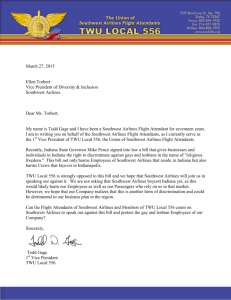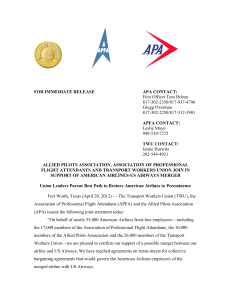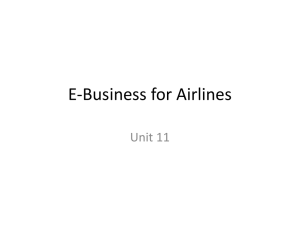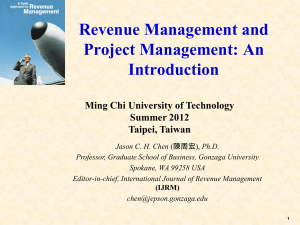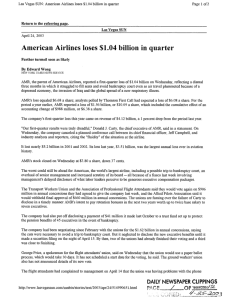Why American Airlines Employees Loathe Management
advertisement
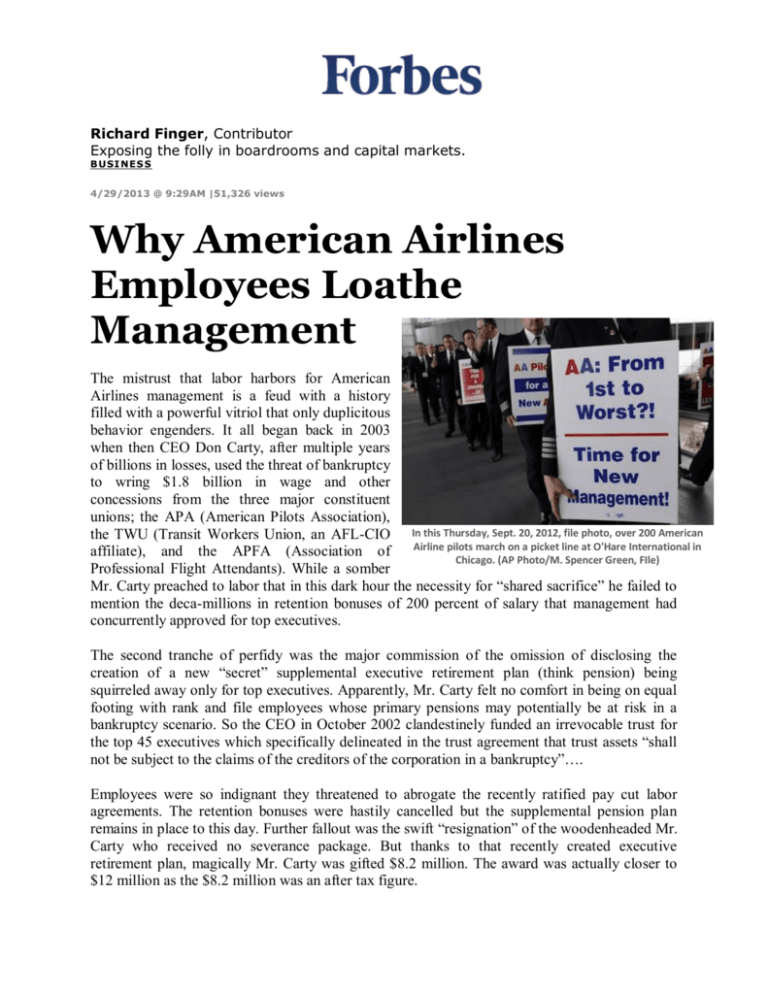
Richard Finger, Contributor Exposing the folly in boardrooms and capital markets. B USI NES S 4/29/2013 @ 9:29AM |51,326 views Why American Airlines Employees Loathe Management The mistrust that labor harbors for American Airlines management is a feud with a history filled with a powerful vitriol that only duplicitous behavior engenders. It all began back in 2003 when then CEO Don Carty, after multiple years of billions in losses, used the threat of bankruptcy to wring $1.8 billion in wage and other concessions from the three major constituent unions; the APA (American Pilots Association), the TWU (Transit Workers Union, an AFL-CIO In this Thursday, Sept. 20, 2012, file photo, over 200 American Airline pilots march on a picket line at O'Hare International in affiliate), and the APFA (Association of Chicago. (AP Photo/M. Spencer Green, FIle) Professional Flight Attendants). While a somber Mr. Carty preached to labor that in this dark hour the necessity for “shared sacrifice” he failed to mention the deca-millions in retention bonuses of 200 percent of salary that management had concurrently approved for top executives. The second tranche of perfidy was the major commission of the omission of disclosing the creation of a new “secret” supplemental executive retirement plan (think pension) being squirreled away only for top executives. Apparently, Mr. Carty felt no comfort in being on equal footing with rank and file employees whose primary pensions may potentially be at risk in a bankruptcy scenario. So the CEO in October 2002 clandestinely funded an irrevocable trust for the top 45 executives which specifically delineated in the trust agreement that trust assets “shall not be subject to the claims of the creditors of the corporation in a bankruptcy”…. Employees were so indignant they threatened to abrogate the recently ratified pay cut labor agreements. The retention bonuses were hastily cancelled but the supplemental pension plan remains in place to this day. Further fallout was the swift “resignation” of the woodenheaded Mr. Carty who received no severance package. But thanks to that recently created executive retirement plan, magically Mr. Carty was gifted $8.2 million. The award was actually closer to $12 million as the $8.2 million was an after tax figure. During the intervening eight year period leading up to the bankruptcy, Mr. Carty’s successor, Gerard Arpey, continued the rich American tradition of, one way or another, of rewarding failure. While recording billions in losses in his own right, Mr. Arpey was insistent in attempting to push through hundreds of millions in executive bonuses. Mr. Arpey, enjoyed regurgitating to the rank and file a pithy little cheer “share the pain, share the gain”. More accurate might have been “all the pain, with none of the gain.” The perpetual struggles of employees protest of executive bonuses in light of their own reduced circumstances leaves many both acrimonious and disillusioned. The covert supplemental retirement plan remains a festering open wound. The airline refuses to issue public disclosures as to its current assets or how much money goes to fund it or where the money comes from. Until the bankruptcy, union representatives had been negotiating since 2008 to reach new labor accords. Only since the bankruptcy with management’s legal right to reject labor contracts has the process moved forward. The Merger: Who’s Getting What Judge Sean Lane has blessed the marriage but the couple won’t be cohabitating for perhaps another six months or so. We know the equity split is 72 percent to 28 percent in favor of American shareholders. Given that stock split and an estimated $1.2 billion in cost efficiencies both secured and unsecured American Airlines creditors are likely to be repaid in full. Doug Parker will be CEO of the combined entity, and Judge Lane disallowed Tom Horton’s $20 million bonus not for any moral reasons, but because it is illegal under bankruptcy law. The board of the new company will have the legal freedom to award Mr. Horton whatever compensation they wish. American Airlines has frozen its employee pension plan which has $18.8 billion is liabilities and an estimated $ 8 billion funding shortfall. Because payments under defined benefit programs are calculated on both years of employee service and a certain percentage of final salary the American unfunded gap likely went down by a few billion. Current employees who retire in twenty years have their benefit computed as of today’s years of service and salary so actuarial future pension liabilities will by definition be reduced. The plan has been replaced with a 401k defined contribution plan where American Airlines will match employee’s contributions up to 5.5 percent of their salary. The company will likely save tens of millions annually under this defined contribution scenario as not everyone will save 5.5 percent of salary every month. Also, this shifts the investment risk from the company to the employee. And come now the egregious insult of a $20 million bonus for caretaker CEO Tom Horton. Here is one more depredation. Regardless of whether Tom Horton receives his undeserved $20 million, he has a pension worth at least $5million. Through accounting legerdemain Horton has been given credit for at least four extra years of American Airlines employment. I almost forgot about employees. Guess what they are getting; the shaft, as usual. I have been in contact with several employees both by phone and e-mail during the past couple of weeks. I got a little detail from a TWU mechanic. In the 2003 giveaway, this gentleman saw his wages reduced 17.5 percent or nearly $20 thousand per year and had vacation time reduced by a week. A decades long American Airlines employee, before the latest new labor contracts he was making a little less than $70, 000 annually. After a decade of wage stagnation, the new post-bankruptcy accord initially calls for a paltry three percent salary increase. But because of increased employee health care cost burdens, a frozen pension and the newly implemented defined contribution 401K program, our example is taking home about $4,400 less per year! While this atrocity was unfolding, the airline and the TWU jointly issued a memorandum which I think was intended as some sort of mission statement delineating myriads of “business improvement opportunities”. There is a climax which specifies areas where “Union and Company agrees……to become best in class.” Like….you just gave me my first raise in ten years which perversely cut my after tax wages by 7 percent………and you throw this nonsense in my face. Are Unions Too Cozy With Management? At least in the case of the flight attendants and the mechanics I have gotten some feedback that many are less than happy about the job that APFA and the TWU are doing representing their interests. Did labor have a strong enough voice at the table? All three unions knew about and approved the $20 million bonus for Tom Horton. All three unions readily agreed to place language in the labor agreements “gagging” employees from complaining about excessive management bonuses. Some are of the opinion that inserting “gag” order language was a quid pro quo for the American Airlines reimbursing APFA $5 million for bankruptcy financial consultants and $2 million to pay investment banking firm Jefferies & Co. American also refunded to the TWU over $2.7 million in bankruptcy related expenses. At least in the case of the TWU, I came into possession of union form LM-2 which is a required annual report to the Department of Labor. Total TWU expenditures were $45.6 million versus $44.8 million in receipts. The point is that $2.7 million is not an insignificant number for the TWU. Top management at all the unions receives a designation A-5 travel pass. With this perk, APFA president Laura Glading and her family can travel first class anyplace, anytime and have priority that can bump a full fare passenger. Ms. Glading can retire at the end of her term with this benefit intact. Her predecessor, Tommy Hitto-Blake retired with A-5 travel. At the time it was kept secret from union membership. Why keep it hidden if there is nothing underhanded going on. I also came into possession of a number of TWU form L-10’s which are disclosures of gifts or perks that American Airlines doles out to union officials. I discovered thousands of dollars in free airline travel, meals, and even baseball tickets. Also, top TWU officers are appointed for life and not elected like counterparts at APA and APFA. If an appointment lacks accountability to those to whom you are to represent, then it becomes little more than a sinecure. Woven all together, a case can be made for an incestuous relationship between union management and executives at American Airlines. Top union officials make $200,000 or $250,000 or more exclusive of perks and benefits worth many thousands more. With these “cushy” jobs does there exist a lack of incentive for these agents of the workers to fight their hardest for them. Judging by the results of the latest rounds of labor negotiations, it is at least a possibility. Deregulation And The Law Of Unintended Consequences When dust has settled, and these two companies begin cohabitating together, the United States will be left with but four airlines that control 90 percent of all domestic traffic. Prior to the October 24, 1978 enactment of the Airline Deregulation Act (“Act”) or the “big bang” in airline jargon, airlines were governed by the now defunct Civil Aeronautics Board. It was a staid if not gentlemanly arrangement. It set fares and granted (or not) licenses to airlines for new routes. The system had functioned for over four decades when in the early 1970’s the Arab oil embargo drastically increased fuel prices and the economy suffered from stagflation. The rate system often subsidized inefficient routes. As air fares were escalating rapidly, congressional pressure mounted to scrap this antiquated bureaucracy. The theory was that an industry once untethered from government shackles would surely thrive under unfettered capitalism. After thirty five years and hundreds of new startup airlines, hundreds of bankruptcies, liquidations, reorganizations, and mergers, in 2013 what are the remnants of the “Act”? The Justice Department evaluates all airline mergers and acquisitions on competitive grounds with the Transportation Department and FAA chirping in background advice. Congress which has the discretion to intervene has opted out of the major mergers between United/Continental and Delta/Northwest. Each mega merger effectively grants near monopoly at many airports and for many routes. Justice denies ATT the right to merge with T-Mobile but yet blesses a United/Continental union that has limited or no competition on many routes. Either doing proper diligence is neglected or it is fair game to call Justice Department competence into question. Will Justice do their usual wink and nod and bless the US Airways/American combination that will create the world’s largest airline? If they do then airline consolidation, with full government blessing, will be complete. Four airlines (United, American/US Air, Southwest, and Delta) will control the domestic skies. Intra market monopolies will predominate to detriment of the traveler. If an aberration occurs and the marriage is denied, pundits question whether either US Airways or American can compete solo against the giant tentacles of United, Delta, and Southwest. So we’re damned if they do and damned if they don’t. With these four mega airlines having near domestic monopoly at many regional airports, contrary to whatever nonsense the consultants parade before Congress, airfares will drastically increase. I live in Houston, Texas and after the United/Continental combination, United now controls over 90 percent of domestic travel in and out of our Houston Intercontinental Airport. Many fights have been consolidated so travelers have fewer choices and fares have been radically increased .The landscape is the same at major airports like Denver, Dallas, and Atlanta. The Future After the multitudes of iterations of three and half decades, the airline industry is now structurally in its most powerful position in the history of aviation; it is poised to reap massive profits from the now entrenched government approved oligopolistic framework. Was this what the framers of the Airline Deregulation Act envisioned? These big four major airlines are all not surprisingly projected to make lots of money in 2013 and 2014. With current industry configuration, I do believe a trained chimpanzee could run these airlines profitably. Within this industry structure of near guaranteed profitability there needs to be significant profit participation formula for TWU, APFA, and APA members. These employees have truly sacrificed and the time has come for a little bit of catch-up. To prevent executives from gaming the system, calculations should be based on the same criteria that any future executive bonuses are based on. Each of the three unions should have a seat on the board of directors to act as a check against management over reach. American Airlines employees have no shortage of grievances to be angry about. It is the cronyism of this management team that serves as a paradigm for why many complain about the unfairness perpetuated in the boardrooms of corporate America. No one can know whether workers will be treated more equitably under the US Airways managers. I only know there is only one way it can go. This article is available online at: http://www.forbes.com/sites/richardfinger/2013/04/29/why-american-airlines-employeesloathe-management/



